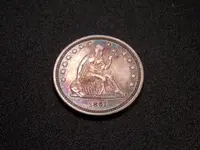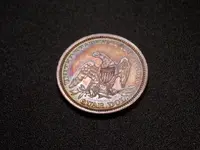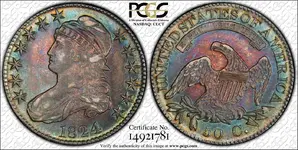II. Harm done by Dipping
Since dipping removes metal, toning, and some other elements at or near the surfaces, much of the character and history of a coin is destroyed. Some people argue that the result is a more desirable coin.
dipped coins Understanding Classic U.S. Coins and Building Excellent Coin Collections, Part 2: Dipped CoinsMany of the coins in the Eliasberg, Norweb and Garrett collections, three of the greatest collections ever auctioned, were all characterized by certain patterns of natural toning, respectively. When an Eliasberg, Norweb, or Garrett coin is dipped, much of the history of the coin is erased, and its pedigree may never again be conclusively documented.
Most sophisticated collectors and most other experts, though not everyone, would agree that there are at least some cases where the harm done by dipping is outweighed by the benefits. If harmful materials have attached to a coin, in some cases, dipping is the least harmful way of removing such materials. If a coin is improperly stored in some peculiar setting, or was living below ground, undesirable substances may have bonded to the surface and, in some such instances, the acid in a standard coin dip is the best way to remove such undesirable substances.
It is also true that some forms of deliberate artificial toning are best removed with dipping, though such cases are very rare. Usually, artificial toning can be removed with running water or acetone.
Suppose that a coin has become covered by thick, black toning or has toning that is so heavy that the coin cannot be fully identified. Yes, it is being stated here that there exist coins for which the benefits of a dipping will probably outweigh the harm done. This, though, is beside the main topic, for two reasons. First, such cases would amount to less than one percent of all instances of classic U.S. coins being dipped. Secondly, experts at the dominant grading services and many influential dealers tend to be accepting of the dipping of high quality coins with attractive, natural toning.
There are a large number of white, classic U.S. silver coins in PCGS or NGC holders with grades of 67 or 68 that were bright white on the day that they each, respectively, were encapsulated. Many of these have been sold to beginning collectors or to ‘investors,’ who are often not familiar with the culture and traditions of coin collecting in the U.S.
https://www.coinweek.com/featured-n...cellent-coin-collections-part-2-dipped-coins/












